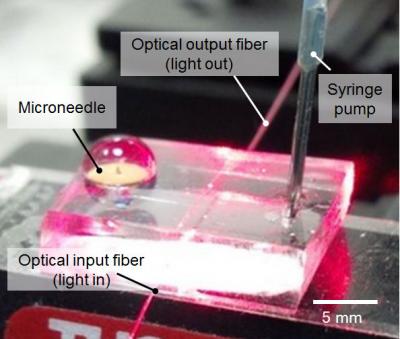Scientists develop painless and inexpensive microneedle system to monitor drugs

Researchers at UBC and the Paul Scherrer Institut (PSI) in Switzerland have created a microneedle drug monitoring system capable of both collecting fluid and performing an analysis to determine the concentration of vancomycin in a patient's bloodstream. Credit: Sahan Ranamukhaarachchi
The new system consists of a small, thin patch that is pressed against a patient's arm during medical treatment and measures drugs in their bloodstream painlessly without drawing any blood. The tiny needle-like projection, less than half a milimetre long, resembles a hollow cone and doesn't pierce the skin like a standard hypodermic needle.
“Many groups are researching microneedle technology for painless vaccines and drug delivery,” said researcher Sahan Ranamukhaarachchi, a PhD student in UBC's faculties of applied science and pharmaceutical sciences, who developed this technology during a research exchange at PSI. “Using them to painlessly monitor drugs is a newer idea.”
Microneedles are designed to puncture the outer layer of skin, which acts as a protective shield, but not the next layers of epidermis and the dermis, which house nerves, blood vessels and active immune cells.
The microneedle created by Ranamukhaarachchi and his colleagues was developed to monitor the antibiotic vancomycin, which is used to treat serious infections and is administered through an intravenous line. Patients taking the antibiotic undergo three to four blood draws per day and need to be closely monitored because vancomycin can cause life-threatening toxic side effects.
The researchers discovered that they could use the fluid found just below the outer layer of skin, instead of blood, to monitor levels of vancomycin in the bloodstream. The microneedle collects just a tiny bit of this fluid, less than a millionth of a millilitre, and a reaction occurs on the inside of the microneedle that researchers can detect using an optical sensor. This technique allows researchers to quickly and easily determine the concentration of vancomycin.
“This is probably one of the smallest probe volumes ever recorded for a medically relevant analysis,” said Urs Hafeli, associate professor in UBC's faculty of pharmaceutical sciences.
“The combination of knowhow from UBC and PSI, bringing together microneedles, microfluidics, optics and biotechnology, allowed us to create such a device capable of both collecting the fluid and performing the analysis in one device,” said Victor Cadarso, a research scientist and Ambizione Fellow at PSI.
###
The microneedle monitoring system, described in a paper published earlier this month in Scientific Reports, was developed out of a research collaboration between Hafeli and Boris Stoeber, a professor in UBC's faculty of applied sciences, and is being commercialized by the UBC spin-off Microdermics Inc.
Media Contact
All latest news from the category: Health and Medicine
This subject area encompasses research and studies in the field of human medicine.
Among the wide-ranging list of topics covered here are anesthesiology, anatomy, surgery, human genetics, hygiene and environmental medicine, internal medicine, neurology, pharmacology, physiology, urology and dental medicine.
Newest articles

First-of-its-kind study uses remote sensing to monitor plastic debris in rivers and lakes
Remote sensing creates a cost-effective solution to monitoring plastic pollution. A first-of-its-kind study from researchers at the University of Minnesota Twin Cities shows how remote sensing can help monitor and…

Laser-based artificial neuron mimics nerve cell functions at lightning speed
With a processing speed a billion times faster than nature, chip-based laser neuron could help advance AI tasks such as pattern recognition and sequence prediction. Researchers have developed a laser-based…

Optimising the processing of plastic waste
Just one look in the yellow bin reveals a colourful jumble of different types of plastic. However, the purer and more uniform plastic waste is, the easier it is to…



